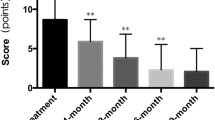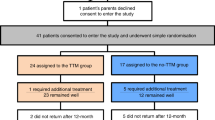Abstract
A number of clinical trials evaluated the effect of topical timolol in the treatment of infantile hemangioma and provided inconsistent results. The present study assessed the response rate and adverse events of topical timolol in the treatment of infantile hemangioma. Pubmed, Embase, China National Knowledge Infrastructure (CNKI), Wanfang, and Cochrane library were searched until October 2016. Specific inclusion criteria were used to evaluate articles. Risk ratios (RRs) with 95% confidence intervals (CIs) were calculated. The meta-analysis was performed using a random effect model. A total of 10 studies, comprising 887 infants with hemangioma, were included. The response rate was reported in eight trials; these studies compared the topical timolol to laser, observation, placebo, or propranolol. The heterogeneity was statistically significant (P < 0.00001, I2 = 83%). The difference in the response rate was significant (RR = 2.86, 95% CI 1.31–6.24) while comparing the topical timolol to the controls. However, no significant difference in the response rate was observed while comparing the topical timolol to propranolol (RR = 0.99, 95% CI 0.70–1.42). The difference in the adverse events was found to be significant (RR = 0.21, 95% CI 0.05–0.97) when the timolol group was compared to the control group. This meta-analysis confirmed that the topical timolol alone was more beneficial on response rate and adverse event than laser, placebo, and observation. The response rate did not differ significantly when comparing the topical timolol to propranolol. However, further studies are essential using an improved design of the study.




Similar content being viewed by others
References
Bayart CB, Brandling-Bennett HA (2015) Beta-blockers for childhood vascular tumors. Curr Opin Pediatr 27:454–459
Chambers CB, Katowitz WR, Katowitz JA, Binenbaum G (2012) A controlled study of topical 0.25% timolol maleate gel for the treatment of cutaneous infantile capillary hemangiomas. Ophthal Plast Reconstr Surg 28:103–106. https://doi.org/10.1097/IOP.0b013e31823bfffb
Chan H, McKay C, Adams S, Wargon O (2013) RCT of timolol maleate gel for superficial infantile hemangiomas in 5- to 24-week-olds. Pediatrics 131(6):e1739-1747. https://doi.org/10.1542/peds.2012-3828
Chang LC, Haggstrom AN, Drolet BA, Baselga E, Chamlin SL, Garzon MC, Horii KA, Lucky AW, Mancini AJ, Metry DW (2008) Growth characteristics of infantile hemangiomas: implications for management. Pediatrics 122:360–367
Chinnadurai S, Fonnesbeck C, Snyder KM, Sathe NA, Morad A, Likis FE, Mcpheeters ML (2016) Pharmacologic interventions for infantile hemangioma: a meta-analysis. Pediatrics 137:e20153896. https://doi.org/10.1542/peds.2015-3896
Danarti R, Ariwibowo L, Radiono S, Budiyanto A (2016) Topical timolol maleate 0.5% for infantile hemangioma: its effectiveness compared to ultrapotent topical corticosteroids—a single-center experience of 278 cases. Dermatology 232:566–571. https://doi.org/10.1159/000448396
Du W, Gerald D, Perruzzi CA, Rodriguezwaitkus P, Enayati L, Krishnan B, Edmonds J, Hochman ML, Lev DC, Phung TL (2013) Vascular tumors have increased p70 S6-kinase activation and are inhibited by topical rapamycin. Lab Invest 93:1115–1127
Gong H, Xu DP, Li YX, Cheng C, Li G, Wang XK (2015) Evaluation of the efficacy and safety of propranolol, timolol maleate, and the combination of the two, in the treatment of superficial infantile haemangiomas. Br J Oral Maxillofac Surg 53:836–840. https://doi.org/10.1016/j.bjoms.2015.09.005
Greenberger S, Bischoff J (2013) Pathogenesis of infantile haemangioma. Br J Dermatol 169:12–19
Guo S, Ni N (2010) Topical treatment for capillary hemangioma of the eyelid using beta-blocker solution. Arch Ophthalmol 128:255–256
Higgins JP, Thompson SG, Deeks JJ, Altman DG (2003) Measuring inconsistency in meta-analyses. BMJ 327:557–560
Higgins JPT, Altman DG, Gøtzsche PC, Jüni P, Moher D, Oxman AD, Savović J, Schulz KF, Weeks L, Sterne JAC (2011) The Cochrane Collaboration’s tool for assessing risk of bias in randomised trials. BMJ 343:d5928
Ji Y, Chen S, Xu C, Li L, Xiang B (2015) The use of propranolol in the treatment of infantile haemangiomas: an update on potential mechanisms of action. Br J Dermatol 172:24–32
Khunger N, Pahwa M (2011) Dramatic response to topical timolol lotion of a large hemifacial infantile haemangioma associated with PHACE syndrome. Br J Dermatol 164:886–888
Lau J, Ioannidis JP, Schmid CH (1997) Quantitative synthesis in systematic reviews. Ann Intern Med 127:820–826
Leaute-Labreze C, Dumas de la Roque E, Hubiche T, Boralevi F, Thambo JB, Taieb A (2008) Propranolol for severe hemangiomas of infancy. N Engl J Med 358:2649–2651. https://doi.org/10.1056/NEJMc0708819
Linjun Y, Jiachuan X, Baoli S, Qixing X, Chunfen L (2015) A clinical study of Timolol maleate eye drops for the treatment of superficial infantile hemangiomas. Zhonghua Zheng Xing Wai Ke Za Zhi 31:440–445
Ma X, Zhao T, Ouyang T, Xin S, Ma Y, Chang M (2014) Propranolol enhanced adipogenesis instead of induction of apoptosis of hemangiomas stem cells. Int J Clin Exp Pathol 7:3809–3817
Ovadia SA, Landy DC, Cohen ER, Yang EY, Thaller SR (2015) Local administration of β-blockers for infantile hemangiomas: a systematic review and meta-analysis. Ann Plast Surg 74:256–262
Pope E, Chakkittakandiyil A (2010) Topical timolol gel for infantile hemangiomas: a pilot study. Arch Dermatol 146:564–565
Li Q, Li J, Yang T (2014) The clinical observation and comparion of propranolole and timolol for infant facial hemangioma. Chin J Aesthet Med 23(3):221–223
Qiu Y, Ma G, Yang J, Hu X, Chen H, Jin Y, Lin X (2013) Imiquimod 5% cream versus timolol 0.5% ophthalmic solution for treating superficial proliferating infantile haemangiomas: a retrospective study. Clin Exp Dermatol 38:845–850. https://doi.org/10.1111/ced.12150
Rizvi SAR, Yusuf F, Sharma R, Rizvi SWA Managment of superficial infantile capillary hemangiomas with topical timolol maleate solution. Semin Ophthalmol 30(1):62–64. https://doi.org/10.3109/08820538.2013.821505
Sacks HS, Berrier J, Reitman D, Ancona-Berk VA, Chalmers TC (1987) Meta-analyses of randomized controlled trials. N Engl J Med 316:450–455
Shah S, Frieden IJ (2013) Treatment of infantile hemangiomas with beta-blockers: a review. Skin Therapy Lett 18:5–7
Sidbury R, Neuschler N, Neuschler E, Sun P, Wang XQ, Miller R, Tomai M, Puscasiu E, Gugneja S, Paller AS (2003) Topically applied imiquimod inhibits vascular tumor growth in vivo. J Invest Dermatol 121:1205–1209
Soltani AM, Reinisch JF (2011) Algorithmic approach to the management of hemangiomas. J Craniofac Surg 22:585–588
Storch CH, Hoeger PH (2010) Propranolol for infantile haemangiomas: insights into the molecular mechanisms of action. Br J Dermatol 163:269–274
Tawfik AA, Alsharnoubi J (2015) Topical timolol solution versus laser in treatment of infantile hemangioma: a comparative study. Pediatr Dermatol 32:369–376. https://doi.org/10.1111/pde.12542
Uihlein LC, Liang MG, Mulliken JB (2012) Pathogenesis of infantile hemangiomas. Pediatr Ann 41:1–6
Wang Y, Geng F, Zha Z, Cheng R, Zhang Z, Weijie SU (2012) Effectiveness of 0.5% Solution of Topical Timolol Maleate for Infantile Hemangiomas. J Tissue Eng Reconstr Surg 8(04):208–212
Weissenstein A (2015) Successful treatment of infantile haemangioma with propranolol. Br J Nurs 24:96–97
Wells G, Shea B, O’connell D, Peterson J, Welch V, Losos M, Tugwell P (2014) The Newcastle-Ottawa Scale (NOS) for assessing the quality of nonrandomised studies in meta-analyses. Appl Eng Agr 18(6):727–734
Yu L, Li S, Su B, Liu Z, Fang J, Zhu L, Huang M, Shan W, Song D, Ye B, Luo C (2013) Treatment of superficial infantile hemangiomas with timolol: evaluation of short-term efficacy and safety in infants. Exp Ther Med 6:388–390. https://doi.org/10.3892/etm.2013.1176
Related articles recently published in Archives of Dermatological Research (selected by the journal’s editorial staff)
de Jong S, Itinteang T, Withers AH, Davis PF, Tan ST (2016) Does hypoxia play a role in infantile hemangioma? Arch Dermatol Res 308:219–227
Li M, Chen Y, Guo Z, Xie Y, Zhou Y, Jiang C, Chen X (2017) The pigment epithelium-derived factor (PEDF): an important potential therapeutic agent for infantile hemangioma. Arch Dermatol Res 309:169–178
Funding
None.
Author information
Authors and Affiliations
Corresponding author
Ethics declarations
Conflict of interest
The authors declare that they have no actual or potential conflicts of interest.
Ethics approval
Not applicable.
Informed consent
Not applicable.
Rights and permissions
About this article
Cite this article
Zheng, L., Li, Y. Effect of topical timolol on response rate and adverse events in infantile hemangioma: a meta-analysis. Arch Dermatol Res 310, 261–269 (2018). https://doi.org/10.1007/s00403-018-1815-y
Received:
Revised:
Accepted:
Published:
Issue Date:
DOI: https://doi.org/10.1007/s00403-018-1815-y




